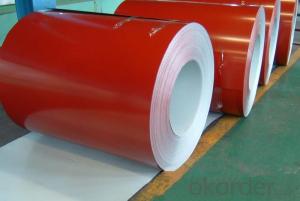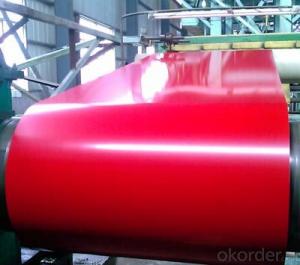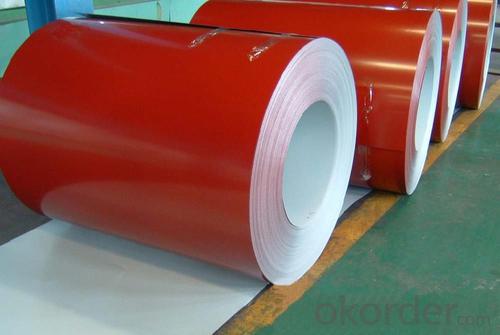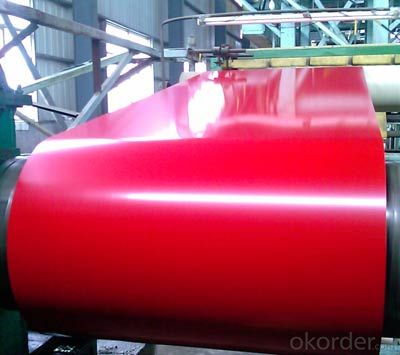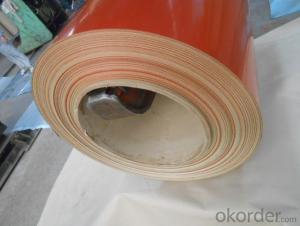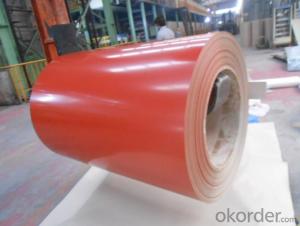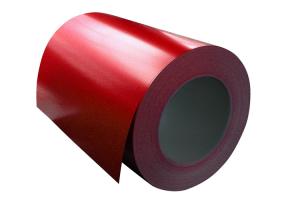Pre-painted Galvanized Sheet Coil with Good Quality in Red
- Loading Port:
- Shanghai
- Payment Terms:
- TT OR LC
- Min Order Qty:
- 100 m.t.
- Supply Capability:
- 10000 m.t./month
OKorder Service Pledge
OKorder Financial Service
You Might Also Like
1.Structure of Pre-painted Galvanized/Aluzinc Steel Coil Description
Pre-painted galvanized steel base metal,after pretreatment,degrease is good capable of decoration.
It generally displays workability, durability and weather resistance.
2.Main Features of the Pre-painted Galvanized/Aluzinc Steel Coil
• good corrosion resistance
• perfect weather resistance
• Good visual effect
• High strength
3.Pre-painted Galvanized/Aluzinc Steel Coil Images

4.Pre-painted Galvanized/Aluzinc Steel Coil Specification
Paint thickness for top side : 5 micron primer + (10-20) microns modified polyester, any RAL color code.
Thickness : 0.14-1.20 mm
Hardness of P: Both soft and hard quality are available
Paint thickness for back side: (5-10) microns Epoxy
Weight per coil: 4-6 tons, also can be upon customer's requirements
Quality standar: JIS G3312 CGCC & CGLCC
Surface finish: with or without protect film
Width : 914mm, 1000mm, 1220mm and 1250mm, thickness 600-1250mm is available
Finish by coil or sheet: Both sheet and coil are available
8Zinc coating: 60-275G/M2, both sides
Max loading weight in one 20ft container : 25 tons generally
5. FAQ of Pre-painted Galvanized/Aluzinc Steel Coil
We have organized several common questions for our clients,may help you sincerely:
1. What is the minimum order quantity ?
we will consider to give more discount if you make big order like 1000 tons and more.
- Q: i have purchased a high dollar Martin guitar and i was wondering if there are many people out there that have used steel string acoustics for classical and flamenco guitar playing.otherwise i will need a nylon stringeror.. uld i put nylon strings on an old yamaha steel string guitar that i have?
- Guitars built for either nylon or steel strings are constructed differently. You will have problems putting nylon strings on a steel stringed guitar and visa verse. I say NEITHER is a good idea. If I were in your shoes, I would walk on line or to a guitar store and purchase a nylon stringed guitar. That's what I did years ago and now I am hooked. I got a second hand Takamine A/E that work just fine for a couple hundred and then just a yr or so ago I got a brand new one, an EC132C and I just LOVE it. As my skills improve I plan on upgrading to a custom built acoustic only with a cutaway. I like cutaways but not the electronics. I never plug into my amp hardly at all. Yamaha makes nylon guitars too VERY cheap and real good tonal quality, I was VERY impressed with one that I played. I upgraded my tuners on my new Takamine to Schaller 16:1 and put the old Takamine tuners on that Yamaha and it's a really nice little guitar to kick around on when I am at that person's place.
- Q: I work the Copper plating line at a custom plating facility in MI.I like to use jumper cables with the jumper cable clamps to help confirm electric current is getting to my parts that I am plating. The acids in the Acid copper is constantly eating the steel and copper clamps. WIll I get a good enough current through stainless steel clamps? I use stainless steel hooks, but our maintenance man thinks that is one of the reasons why I have prblems with my parts turning out. I still think it has to do with the clamps getting eatin up. My question is Is stainless steel as good or reliable enough to run an electrical current to my parts if I am using stainless steel or is it best to use another method to try and get a better connection.Please state your sources or experience with working with electricity. I need to get honest answers and not this is my opinion. We are talking about my making a living so this is important to me so I can bring food home to my table. Thanks for all the help.
- I can only guess. I can't even tell if you are plating some other metal with copper OR if you are plating copper with some other metal. you state that you use the copper clamps only to confirm the current, but I don't see how that works. I suspect that the plating current actually goes through these clamps, so conductivity is very important. But, the conductivity of SS is about 1/5th that of copper, so that will definitely have an effect, and not a good one. .
- Q: How are steel coils processed for heat treatment?
- Steel coils are typically processed for heat treatment by first being uncoiled and then cleaned to remove any dirt or scale. The coils are then heated to a specific temperature, which is determined based on the desired properties of the steel. This temperature is maintained for a specific period of time to allow for the desired transformation of the steel's microstructure. After the heat treatment process is complete, the coils are cooled either slowly or rapidly, depending on the desired properties. This allows the steel to be hardened or softened as required. Finally, the coils are recoiled and prepared for further processing or shipment.
- Q: How are steel coils used in the manufacturing of pipes and tubes?
- Steel coils are used in the manufacturing of pipes and tubes by being unwound and fed into a pipe or tube mill. The steel coils are then shaped and welded together to form a continuous pipe or tube, which is further processed and finished according to specific requirements.
- Q: How are steel coils protected against corrosion?
- Steel coils are protected against corrosion through various methods such as applying protective coatings, galvanizing, or using corrosion inhibitors. These measures help to create a barrier between the steel surface and the surrounding environment, preventing the onset of corrosion and extending the lifespan of the coils.
- Q: What are the different methods of slitting edge trimming for steel coils?
- There are several methods of slitting edge trimming for steel coils, including rotary shear slitting, crush cutting, and laser cutting. Each method has its advantages and disadvantages, depending on factors such as the desired precision, speed, and the type of steel being processed.
- Q: I'm searching for the elastic modulus of ASTM A653 galvanized steel sheet. Max points for first person with a response that includes web address of reliable reference - I just haven't found it yet. thanks!
- I've okorder /
- Q: What are the cost considerations when purchasing steel coils?
- When purchasing steel coils, there are several cost considerations to take into account. Firstly, the price per ton of the steel coils is a significant factor. This can vary depending on factors such as the grade and quality of the steel, market demand, and supplier pricing. Secondly, transportation costs should be considered, as steel coils are heavy and may require special handling and shipping arrangements. Additionally, potential additional costs such as taxes, customs duties, insurance, and storage fees should be factored in. Lastly, the total cost of ownership, which includes factors like maintenance, repair, and energy consumption, should be considered to ensure a comprehensive understanding of the overall cost implications of purchasing steel coils.
- Q: How are steel coils inspected for uniformity?
- Steel coils are inspected for uniformity through visual examination and various non-destructive testing techniques. These include measuring the dimensions and weight of the coils, checking for any surface defects or damages, and conducting magnetic particle or ultrasonic testing to detect any internal flaws or irregularities. Additionally, the coils may undergo chemical composition analysis to ensure uniformity in the steel's properties.
- Q: How are steel coils used in the manufacturing of pressure vessels?
- Steel coils are used in the manufacturing of pressure vessels as they provide a strong and durable material for construction. These coils are typically formed into cylindrical shapes, which are then welded together to create the vessel. The steel coils provide the necessary strength to withstand high pressure and ensure the safety and reliability of the pressure vessel.
Send your message to us
Pre-painted Galvanized Sheet Coil with Good Quality in Red
- Loading Port:
- Shanghai
- Payment Terms:
- TT OR LC
- Min Order Qty:
- 100 m.t.
- Supply Capability:
- 10000 m.t./month
OKorder Service Pledge
OKorder Financial Service
Similar products
Hot products
Hot Searches
Related keywords
